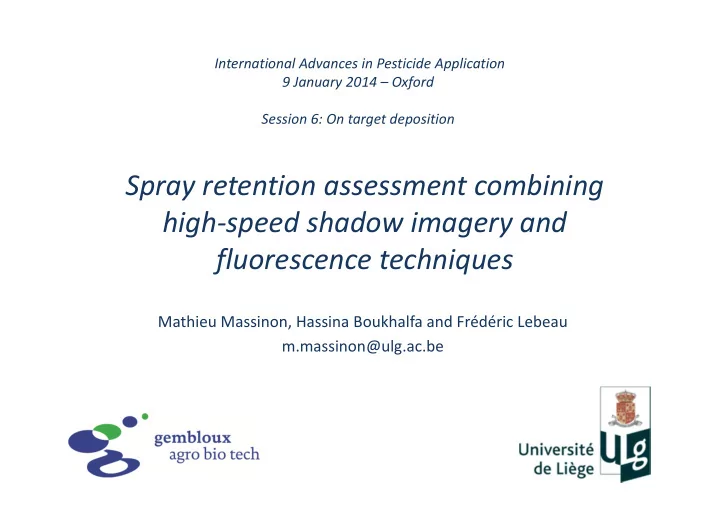

International Advances in Pesticide Application 9 January 2014 – Oxford Session 6: On target deposition Spray retention assessment combining high-speed shadow imagery and fluorescence techniques Mathieu Massinon, Hassina Boukhalfa and Frédéric Lebeau m.massinon@ulg.ac.be
Spray retention • Retention is mainly associated with droplet primary adhesion, while bouncing and splashing are seen as detrimental • Impact outcomes depend on leaf surface and spray mixture properties 2
Leaf surface • A difficult-to-wet leaf is simultaneously characterised by: – its hydrophobic surface : waxes render the surface hydrophobic – its micro-topography reducing the contact area available for droplets: veininess, hairiness: enhance the water repellency of the hydrophobic leaf surface • Lotus effect: the water droplet static contact angle can exceed 150° = superhydrophobicity 3
Spray mixture • On superhydrophobic species, surfactants are often used to enhance spray formulation performances by affecting the physicochemical properties of droplets, i.e. surface tension • Surfactants are known to modify the wetting behaviour of the droplets on the leaf surface by increasing the spreading • Dynamic surface tension = variation over time of liquid surface tension 4 http://www.break-thru.com/
Wetting models The Cassie-Baxter regime The Wenzel regime (non-homogeneous wetting) (homogeneous wetting) = Extreme water repellency pinning 5
Possible impact outcomes Transition from Cassie-Baxter to Wenzel wetting regime is possible because of high impact pressure and low DST 6
Objectives • The aims of the study are dual – Propose a methodology for characterising spray impact on leaves relying on the simultaneous observation of droplet impacts by high speed imaging and fluorescent tracer analysis of deposits – Quantify the amount remaining on a leaf after primary impact of droplets in Wenzel’s wetting regime on horizontal barley leaves 7
Dynamic test bench � 50 cm nozzle height 2 m/s CMOS LED Lens 20000 fps lighting Target surface 8
High speed imaging image processing 1) Digital image: ROI above the leaf 2) Background soustraction 3) Image binarisation 4) Droplet detection and identification 5) Droplet size 6) Droplet coordinates on 2 frames 7) Droplet velocity ��²� 8) Dimensionless Weber number We = � 9) Impact outcome identification according to the physical classification 9
Barley leaves • Indoor grown • Excised leaves: 10mm x 3mm 10
High speed imaging data analysis: energy classes • Tap water + 0.2g/L fluorescein on barley leaf • XR11003VK @2bars 160 L/ha , 10 sprayings 11
High speed imaging data analysis: energy classes • Tap water + 0.1%v/v Break-Thru S240 + 0.2g/L fluorescein on barley leaf • XR11003VK @2bars 160 L/ha, 10 sprayings 12
High speed imaging data analysis: energy classes • Tap water + 0.25%v/v Li-700 + 0.2g/L fluorescein on barley leaf • XR11003VK @2bars 160 L/ha, 10 sprayings Retention: tap water < Li-700 < Break-Thru S240 13 DST: tap water > Li-700 > Break-Thru S240
High speed imaging data processing: evaporation • Because of evaporation, fluorescein concentrations in droplets increase • Correction of the measured volume is required for making correlation between the two techniques • This was achieved by resolving equations for the droplet transport, heat and mass transfer (according to Guella 2008, International Journal of Thermal Sciences 47 886–898) 14
Spray retention comparison between techniques (µl/0.3 cm²) ��������� � �������� � � ∗ ��������� ������ K = % of droplet volume splashing in Wenzel regime that remains on the leaf due to pinning 15
Spray retention pinning percentage K K K 16
Conclusions • Depending on the spray mixture, droplets fragmented in Wenzel regime accounted for 28-46% of retention at first impact, with a clear ranking as a function of DST • This contribution is not negligible and should be considered when modelling spray retention processes, especially on early growth stages and when using low-drift nozzles with surfactants (larger droplets more likely to splash) • The coexistence of impact outcomes for the same impact energy is also important to be considered in retention models 17
High speed imaging results: volume percentages • Ten trials 18
Recommend
More recommend